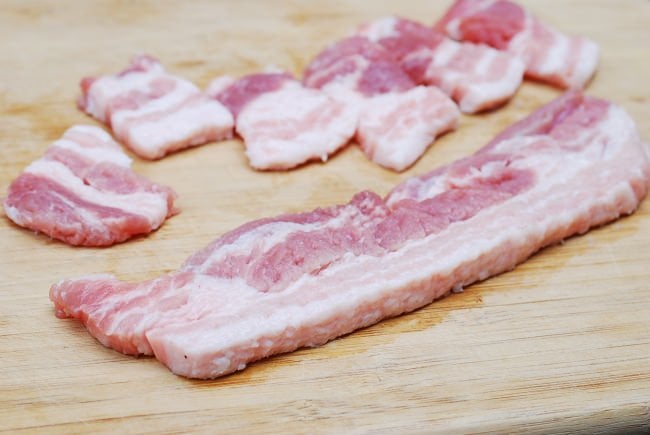
Grilling is enormously popular in Korean cuisine. I’m sure many of you have been to a smoke-filled Korean restaurant where you grill your meat at the table. I’ve shared a number of marinated Korean BBQ recipes. Here, we are grilling pork belly, samgyupsal (삼겹살).
Samgyupsal gui, (삼겹살 구이) is especially popular among young people often with alcohol drinks. It’s relatively cheap and easy to cook at home because you don’t need to prepare a marinade. My family loves it too!
You can easily find thinly sliced pork belly in Korean markets. The thickness varies from paper thin (or shaved) slices to about 1/4 to 1/2-inch thick ones.
While my family generally prefers thick cuts, grilled shaved pork belly is also delicious and melts in the mouth.
How to grill pork belly
The fresh meat is grilled without seasoning or marinating. You can cook the strips of samgyupsal in large pieces or in bite size pieces. When cooking large pieces, you can cut cooked pieces with a pair of kitchen scissors on the grill/pan.
We usually grill pork belly with other vegetables such as garlic, mushrooms, and chili peppers. Onions, scallions, kongnamul (soybean spourts), and kimchi are delicious fried with pork belly as well.

At home, we use a portable gas grill or electric grill to cook at the table, or we fire up the grill outside. Traditionally, grilling is done over wood charcoal (sootbul, 숯불), which is considered the best heat source for Korean grilling and used by many good Korean BBQ restaurants.
Korean table grills usually have a hole for the fat to drain off to a drip pan or a plate. If using a regular pan, you will need to use a paper towel to soak up the fat so it doesn’t smoke.

What to serve grilled pork belly with
Lettuce wraps are a must! We also love kkaennip (perilla leaves) as wraps. The unique flavor of kkaennip pairs deliciously with samgyupsal.
Dip a piece of cooked meat in the sesame oil sauce made with salt, pepper and sesame oil. Then, wrap it in a lettuce leaf with a dollop of ssamjang and pa muchim (scallion salad) or simply sliced scallions.
As is the case with bossam, saewujeot (새우젓), fermented salted shrimp, is always delicious with pork.

For more Korean cooking inspirations, follow along on YouTube, Pinterest, Twitter, Facebook, and Instagram.

Ingredients
- 1 pound sliced fresh pork belly (samgyupsal, 삼겹살)
- 8 cloves garlic, thinly sliced
- 4 green chili peppers, roughly sliced
- 3 - 4 scallions, thinly sliced (or pa muchim)
- 2 to 4 ounces mushroom caps - white, crimini, or king mushrooms - optional
- 4 chili peppers - optional
- 2 heads of red or green lettuce
- 16 perilla leaves, kkaennip (깻잎) - optional
Sesame oil sauce (per person):
- 1 tablespoon sesame oil
- 1/2 teaspoon salt
- black pepper to taste
Ssamjang (for wraps) - serves 4
- 2 tablespoons doenjang 된장 (Korean soybean paste)
- 1 tablespoon gochujang 고추장 (Korean red chili pepper paste)
- 1 teaspoon minced garlic
- 2 teaspoons sesame oil
- 1 teaspoon sesame seeds
- 1 tablespoon rice wine or mirin - optional If the sauce is too thick, use a tablespoon of water to thin it.
Instructions
- Prepare the vegetables. Mix the sauce ingredients for each sauce.
- Heat the grill (or a flat pan or grill pan). Cut the pork belly strips in shorter bite size pieces. You can also grill first and cut into bite sized pieces with kitchen scissors.
- Add the meat to the grill along with the garlic, chili peppers, and any other vegetables you are using. Grill over moderate heat until cooked through, flipping once. It's best to serve right off the grill or pan as you cook.
























